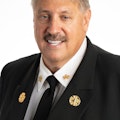A newly released report from the U.S. Department's National Institute of Standards and Technology (NIST) titled, "Firefighter and Safety Deployment Study — Report on EMS Field Experiments," concludes that the more emergency personnel on a medical scene, the faster critical tasks were done and the faster the patient was accessed and removed. The faster the patient is accessed and removed, or critical tasks are done, the better for the patient.
The study was funded through the Assistance to Firefighters Grant (AFG) Program and conducted in partnership with a variety of organizations, including the International Association of Fire Chiefs (IAFC), International Association of Fire Fighters (IAFF), Commission on Fire Accreditation International (CFAI), National Institute of Standards and Technology (NIST) and Worcester Polytechnic Institute (WPI).
Personnel from the Fairfax County, VA, Fire and Rescue Department and the Montgomery County, MD, Fire and Rescue Department were active participants in the performance tasks. No other study of this type has ever been conducted and it is a true look at how different crew sizes and different crew configurations between basic life support (BLS) and advanced life support (ALS) providers can affect patient care.
The fire service is the largest provider of emergency medical services in the United States. The fire service also has the largest amount of transport ambulances in the U.S., so when one considers that the fire service is the largest provider of emergency medical services, this study has far-reaching implications for how fire chiefs determine policy when sending fire personnel and apparatus to a scene.
The study shows the effects of 102 field experiments using different crew configurations and ALS providers under three scenarios: patient access and removal from an incident scene; a victim of systemic trauma due to a long-distance fall; and a patient with chest pain leading to cardiac arrest.
The first responder crew size varied from two, three, and four-person staffing; arrival times also varied. The ALS configurations for the first responder company and the transport ambulance were also varied. In each experiment, tasks had to be performed by crews that were consistent with the scenario. For example, in the cardiac arrest scenario, intubation had to be performed by an ALS provider. Each task was timed to determine how long it took to perform the task. The results were measured and the effectiveness of the performed functions was measured with the different crew configurations.
The results showed a statistical and remarkable difference in many cases. This was especially true for patient removal using different crew-size configurations. Crews with three and four first responders were able to remove the patient 1.2 to 1.5 minutes faster than first responders with two people. And when it was only an ambulance with two people, the times varied from 2.6 to 4.1 minutes less to remove a patient from a home.
The same results were evident in performing tasks such as taking blood pressure, starting an IV, intubating and putting an EKG monitor on the patient when the researchers looked at the time to complete the tasks in the trauma and cardiac event scenarios.
I have heard from critics of this study that patient outcomes were not measured, so therefore we cannot prove that performing certain tasks, or accessing and removing the patient faster were positive for the patient. Their logic makes no sense. If that was the case, we would not staff trauma centers 24 hours a day with the necessary personnel. Can you imagine the patient outcomes if a patient suffered a gunshot wound at 11 P.M., but had to wait until the next morning for the surgeons to come to work because they only work from 9 A.M. to 5 P.M.? Time is critical is many life-and-death situations.
During these tough economic times, the findings are especially important when decision-makers are quick to slash department budgets and manpower. Hopefully, they will heed the conclusions and not be so quick to cut.
GARY LUDWIG, MS, EMT-P, a Firehouse® contributing editor, is a deputy fire chief with the Memphis, TN, Fire Department. He has 33 years of fire-rescue experience. Ludwig is chair of the EMS Section for the International Association of Fire Chiefs (IAFC), was appointed to the National EMS Advisory Council by the U.S. Secretary of Transportation and is a member of the International Association of Fire Fighters (IAFF) EMS Standing Committee. Ludwig has master's degree in business and management and is a licensed paramedic. He is a frequent speaker at fire and EMS conferences nationally and internationally and can be reached through his website at www.garyludwig.com.
About the Author
Gary Ludwig
GARY LUDWIG has served in three fire departments over his career: St. Louis, Memphis, and Champaign, IL. His fire, EMS and rescue career spanned a total of 46 years, and he has been a paramedic for over 44 years. Ludwig served as president of the International Association of Fire Chiefs in 2019-20. He has a Master’s degree in Business and Management, has written over 500 articles for professional fire and EMS publications and is the author of seven books.
Connect with Gary
Email: [email protected]
Facebook: Gary Ludwig
Twitter: @ChiefGaryLudwig
Website: garyludwig.com
